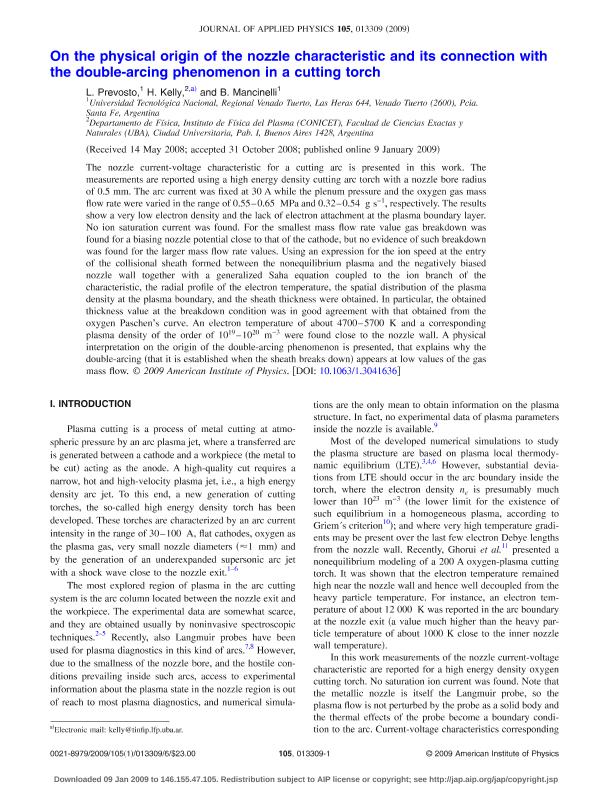Mostrar el registro sencillo del ítem
dc.contributor.author
Prevosto, Leandro

dc.contributor.author
Kelly, Hector Juan

dc.contributor.author
Mancinelli, Beatriz Rosa

dc.date.available
2018-10-02T15:27:21Z
dc.date.issued
2009-12
dc.identifier.citation
Prevosto, Leandro; Kelly, Hector Juan; Mancinelli, Beatriz Rosa; On the physical origin of the nozzle characteristic and its connection with the double-arcing phenomenon in a cutting torch; American Institute of Physics; Journal of Applied Physics; 105; 1; 12-2009; 13309-13315
dc.identifier.issn
0021-8979
dc.identifier.uri
http://hdl.handle.net/11336/61510
dc.description.abstract
The nozzle current-voltage characteristic for a cutting arc is presented in this work. The measurements are reported using a high energy density cutting arc torch with a nozzle bore radius of 0.5 mm. The arc current was fixed at 30 A while the plenum pressure and the oxygen gas mass flow rate were varied in the range of 0.55-0.65 MPa and 0.32-0.54 g s-1, respectively. The results show a very low electron density and the lack of electron attachment at the plasma boundary layer. No ion saturation current was found. For the smallest mass flow rate value gas breakdown was found for a biasing nozzle potential close to that of the cathode, but no evidence of such breakdown was found for the larger mass flow rate values. Using an expression for the ion speed at the entry of the collisional sheath formed between the nonequilibrium plasma and the negatively biased nozzle wall together with a generalized Saha equation coupled to the ion branch of the characteristic, the radial profile of the electron temperature, the spatial distribution of the plasma density at the plasma boundary, and the sheath thickness were obtained. In particular, the obtained thickness value at the breakdown condition was in good agreement with that obtained from the oxygen Paschen's curve. An electron temperature of about 4700-5700 K and a corresponding plasma density of the order of 1019 - 1020 m-3 were found close to the nozzle wall. A physical interpretation on the origin of the double-arcing phenomenon is presented, that explains why the double-arcing (that it is established when the sheath breaks down) appears at low values of the gas mass flow. © 2009 American Institute of Physics.
dc.format
application/pdf
dc.language.iso
eng
dc.publisher
American Institute of Physics

dc.rights
info:eu-repo/semantics/openAccess
dc.rights.uri
https://creativecommons.org/licenses/by-nc-sa/2.5/ar/
dc.subject
Cutting Torches
dc.subject
Double Arcing
dc.subject
Langmuir Probes
dc.subject.classification
Astronomía

dc.subject.classification
Ciencias Físicas

dc.subject.classification
CIENCIAS NATURALES Y EXACTAS

dc.title
On the physical origin of the nozzle characteristic and its connection with the double-arcing phenomenon in a cutting torch
dc.type
info:eu-repo/semantics/article
dc.type
info:ar-repo/semantics/artículo
dc.type
info:eu-repo/semantics/publishedVersion
dc.date.updated
2018-10-01T15:55:10Z
dc.journal.volume
105
dc.journal.number
1
dc.journal.pagination
13309-13315
dc.journal.pais
Estados Unidos

dc.journal.ciudad
Nueva York
dc.description.fil
Fil: Prevosto, Leandro. Consejo Nacional de Investigaciones Científicas y Técnicas; Argentina. Universidad Tecnológica Nacional. Facultad Regional Venado Tuerto; Argentina. Consejo Nacional de Investigaciones Científicas y Técnicas. Oficina de Coordinación Administrativa Ciudad Universitaria. Instituto de Física del Plasma. Universidad de Buenos Aires. Facultad de Ciencias Exactas y Naturales. Instituto de Física del Plasma; Argentina
dc.description.fil
Fil: Kelly, Hector Juan. Universidad de Buenos Aires. Facultad de Ciencias Exactas y Naturales; Argentina. Consejo Nacional de Investigaciones Científicas y Técnicas; Argentina. Consejo Nacional de Investigaciones Científicas y Técnicas. Oficina de Coordinación Administrativa Ciudad Universitaria. Instituto de Física del Plasma. Universidad de Buenos Aires. Facultad de Ciencias Exactas y Naturales. Instituto de Física del Plasma; Argentina
dc.description.fil
Fil: Mancinelli, Beatriz Rosa. Universidad Tecnológica Nacional. Facultad Regional Venado Tuerto; Argentina
dc.journal.title
Journal of Applied Physics

dc.relation.alternativeid
info:eu-repo/semantics/altIdentifier/doi/http://dx.doi.org/10.1063/1.3041636
Archivos asociados
